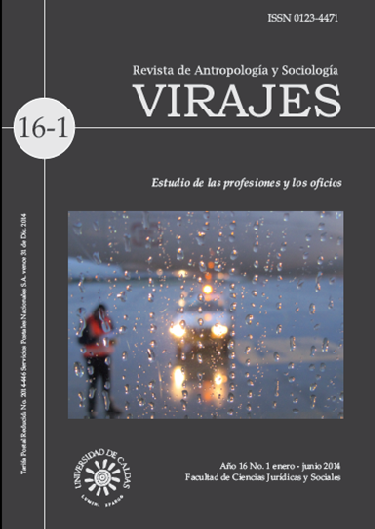Authors
Abstract
State and society relations have moved from coercive totalitarian to democratic persuasive governance relationships in which citizens participate in evaluating their rulers’ actions. In public safety, civil society has been divided into two sectors: observatories and vulnerable citizens. The first sector has built a dialogue with their rulers while evaluating their performance and, from their management performance they set priorities for crime prevention and crime fighting. However, it is in the most vulnerable sector of the civil sphere where a series of emotions are brewing which have been considered of utmost importance in this work to explain the new relationship between the political and civil spheres. With a nonrandom sample of 170 Huasteca community residents, the present study found a relationship between anger and distrust; however the mean square error of approximation suggests a new specification of the proposed model.
Keywords
References
AYALA, J.(2010). “Emociones y estilos de personalidad”. En: Eureka, 7. Cádiz: Universidad de Cádiz.
BAUSELA, E. (2005). “Modelo alternativo de evaluación de la personalidad. Modelo de los cinco factores, modelo 16PF”. En: Avances en Salud Mental Relacional,4. Bilbao:Fundación OMIE.
BELLI, S. (2010). “La construcción de una emoción y su relación con el lenguaje: revisión y discusión de un área importante de las ciencias sociales”. En: Theoria,18. Concepción: Universidad del Bío-Bío.
BERMÚDEZ, E. (2000). “El desanclaje de la política”. En: Espacio Abierto,9. Zulia: Universidad de Zulia.
BOLÍVAR, C., CONTRERAS, J.,JIMÉNEZ, M.,CHAUX, E. (2010). “Desentendimiento moral y dinámicas del robo escolar”. En: Revista de Criminología,52. Madrid: UNED.
ELIZALDE,A. (2010). “Estudio descriptivo de las estrategias de afrontamiento del bullying en profesorado mexicano”. En: Education &Psychology, 8.Washington:American Psychological Association.
FERNÁNDEZ, C., REVILLA, J., DOMÍNGUEZ, R. (2010). “Las emociones que suscita la violencia en televisión”. En: Revista Científica de Educomunicación,36. Andalucía: Grupo Comunicar.
GARCÍA-LIRIOS, C. (2012). “Estructura perceptiva de inseguridad en universitarios”. En: Liberabit,17. Lima: USMP.
GIBSON, C., SULLIVAN, C.,JONES, S., PIQUERO, A. (2010). “Does it take village? Assessing neighborhood influences of children’s self-control”. En: Journal of Research in Crime and Delinquency, 47. New York: University of New York.
GIDDENS, A. (2011). La constitución de la sociedad. Bases para la teoría de la reestructuración. Buenos Aires: Amorrortu Editores.
GUEDES, S.,ÁLVARO, J. (2010). “Naturaleza y cultura en el estudio de las emociones”. En: RevistaEstudiosSociales,13. Bogotá: Universidad de los Andes.
HEYNSECK, H.(2006).The biological basis of personality.New Jersey: TransactionPublishers.
JIMENO, M.(2007). “Cuerpo personal y cuerpo político. Violencia, cultura y ciudadanía neoliberal”. En: UniversitasHumanística,63. Bogotá: Universidad Javeriana.
KLINE, R. (1998). Principles and practice of structural equation modeling.New York: GuilfordPress.
LÓPEZ, M., NÚÑEZ, M. (2009). “Psicopatía versus trastorno antisocial de la personalidad”. En: Revista Española de InvestigaciónCriminológica,7. Madrid: SEIC.
MALONE, M. (2010). “The verdict is in: The impact of crime on public trust in Central American Justice System”. En: Journal of Politics and Latin American, 3. Hamburg: GIGA.
MUÑOZ, D.,MARTÍNEZ, J. (2007). “Aproximaciones conceptuales a las políticas juveniles: desmodernización, anticipación moral y política de vida”. En: Universitas Humanística,64. Bogotá: Universidad Javeriana.
OLIVA, F., HERNÁNDEZ, M., CALLEJA, N. (2010). “Validación de la versión mexicana del inventario de expresión de ira estado rasgo (STAXI-2)”. En: Acta Colombiana de Psicología,13. Bogotá: Universidad Católica de Colombia.
REDONDO, S., PUEYO, A. (2007). “La psicología de la delincuencia”. Papeles del Psicólogo,28. Madrid: Consejo General de Psicología de España.
RUÍZ, J. (2010). “Eficacia colectiva, cultura ciudadana y victimización: un análisis exploratorio con sus relaciones con diversas medidas de miedo al crimen”. En: Acta Colombiana de Psicología,13.Bogotá: Universidad Católica de Colombia.
SÁNCHEZ, C.,CEREZO, F. (2010). “Variables personales y sociales relacionadas con la dinámica bullying en escolares de educación primaria”. En: Electronic Journal of Research in Education Psychology,8. Almeria: Universidad de Almeria.
SILVEIRA, A., ASSUNÇÀO, R., FIGEIREDO, B., BEATO, C. (2010).“Impact of the staying alive programo on the reduction of homicides in a community in Belo Horizonte”.En: Revista SaùdePùblica,44. Sao Paulo: Universidade de Sao Paulo.
TRUJANO, M. (2011). “La individualidad altamente reflexive”. En: Argumentos,24. Lima: Instituto de EstudiosPeruanos.

 PDF (Español)
PDF (Español)
 FLIP
FLIP














